How To Start Training With Gymnastic Rings
For strength, lean muscle and shoulder health, get into using gymnastic rings. Here’s how
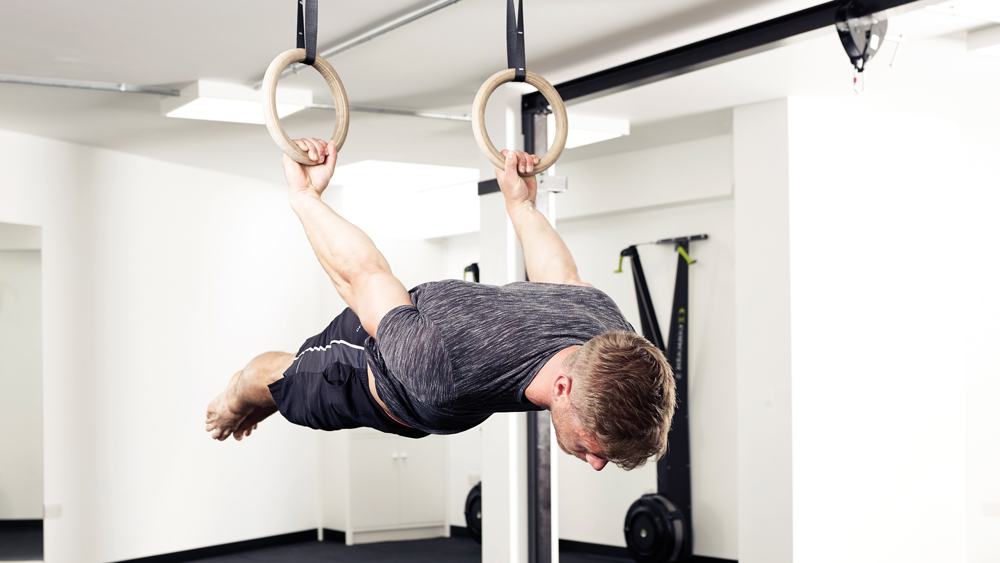
Photography: Glen Burrows. Model: James Stark
If you’re like most of the population, your first look at gymnastics rings probably came via the Olympics, courtesy of improbably-muscled athletes doing moves that look like Batman’s warm-up.
But now, thanks to the popularity of CrossFit and calisthenics training, more and more gyms are dangling rings from the rafters (and reasonably priced sets are readily available online) – even if it’s still rare to see anyone use them for anything other than dips or pull-ups. But there’s a middle ground between the basics and the Olympians, and it makes sense to find it.
If smartly planned, ring training combines strength, hypertrophy and joint health, forcing your body to work in unexpected ways and build the straight-arm strength that’s so important in calisthenics.
“They’ll also allow you to work your shoulders through ranges where they’d normally be weak, helping your shoulder joints get healthy and strong,” says James Stark, an ex-gymnast and calisthenics coach. “Some people go too far too fast, but with appropriate progressions, it’s an excellent form of training.”
Finally, there’s another, less obvious benefit. Moves like the pull-up and dip can put excess strain on the elbows if you do them every day, since your wrist wants to naturally rotate but can’t. Rings provide a simple solution, because they let your wrists rotate throughout the movement.
With joint health taken care of, you can embrace high-frequency training – and since you can sling your rings up anywhere, you can use them more often than your thrice-weekly trips to the gym might allow. Time to ring some changes.
Get the Coach Newsletter
Sign up for workout ideas, training advice, reviews of the latest gear and more.
3 Gymnastic Rings Moves In Brief
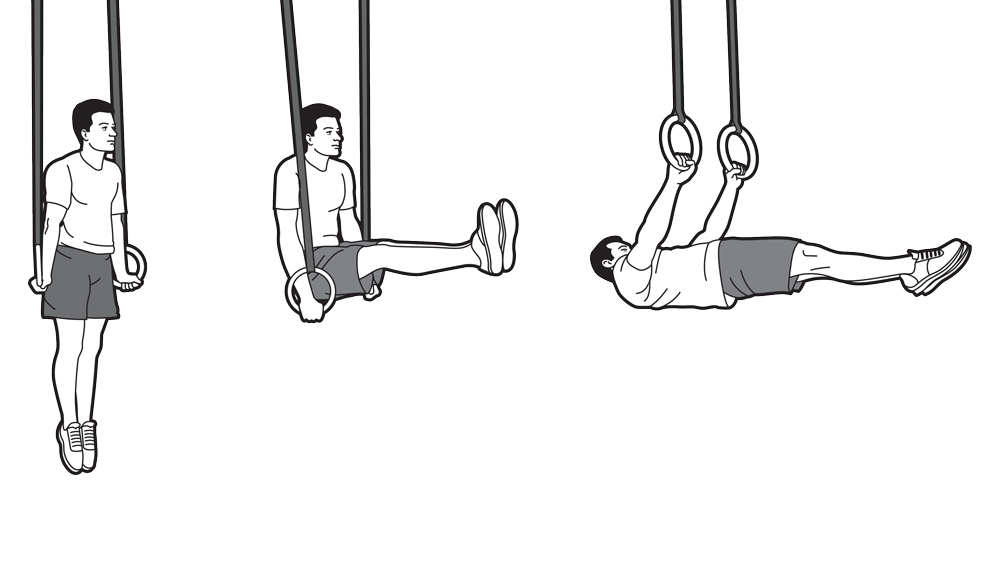
Illustration: Sudden Impact. Left to right: Support, L-sit, lever.
There’s a huge amount of info in our comprehensive guide below, so if you want a sense of where to start and the destination, here’s what you’re letting yourself in for.
Support
This position doesn’t look like much, but it’s tough to hold. Most people start with straight arms held close to their sides, but gymnasts aim to turn their hands out until their palms face forwards, locking out their elbows for better efficiency. Train it with five- to ten-second holds, then graduate to using it during dips – even if you can do ten strict ring dips, you’ll probably struggle to do five with an effective turnout at the top of each rep. It’s also surprisingly tough on your core.
L-sit
The L-sit is the most effective abs move you (probably) aren’t doing. As well as working your core, it’ll improve your shoulder health and also hit your arms. Get into the top support position and bring your legs up parallel to the ground – if even this is too tough, you’ll need to start with your legs bent, or extended one at a time. Work up to ten to 15 seconds on each variation before moving on to the next one, and if your triceps get too tired, try it from the even-tougher dead hang.
Lever
Looks impossible? Surprise: the front lever is just very, very hard. Even five seconds of holding, which would be tough, will tax your core and lower back but also your pulling muscles, making it a potent mass-builder. Start with 30- to 60-second holds on the ground (feet and shoulder blades off the floor), then move up to hanging from the rings and trying to get your back parallel to the floor, with your legs tucked, pulling down on the rings. Now just straighten those legs…
Getting Set Up With Gymnastic Rings
Here’s what you need to know before you start your ring training regime
What type of rings should I get?
Wood is most comfortable on the wrists and easy to grip, but expensive. Plastic is cheaper, and you can hang them out in any weather. Metal is ultra-durable but not friendly on your wrists. If it fits your budget, wood’s the best bet – it also absorbs sweat, meaning you’ll be able to hold on better when things get tricky.
Where should I hang them?
A tree branch or outdoor pull-up bar is ideal, if it’s sturdy enough. At home, you can use rafters in your garage, a door-mounted pull-up bar – though not for “inverted” moves – or eyelets bolted to your ceiling, if you’re the DIY type. Alternatively, take them to the gym. Just ask before you hang them up.
How high should they be?
It depends on your training. Generally, you’ll train above-the-ring and below-the-ring moves separately, so there’s no problem with adjusting their height between rounds. Until you can do the basics under control, it’s always a good idea to be able to touch the ground at any point during a movement, so you can dismount under control if your strength fails you.
The Starter Plan
Before anything else, you should self-assess to make sure you’ve got the strength, control and shoulder flexibility to pull off tougher moves. One advantage of rings training is the increased range of motion it allows, but without strong shoulder ligaments, that can cause trouble. If you can do the below, you’re all set; if not, start on one rep or three seconds of each move, and increase it with every workout.
Top support
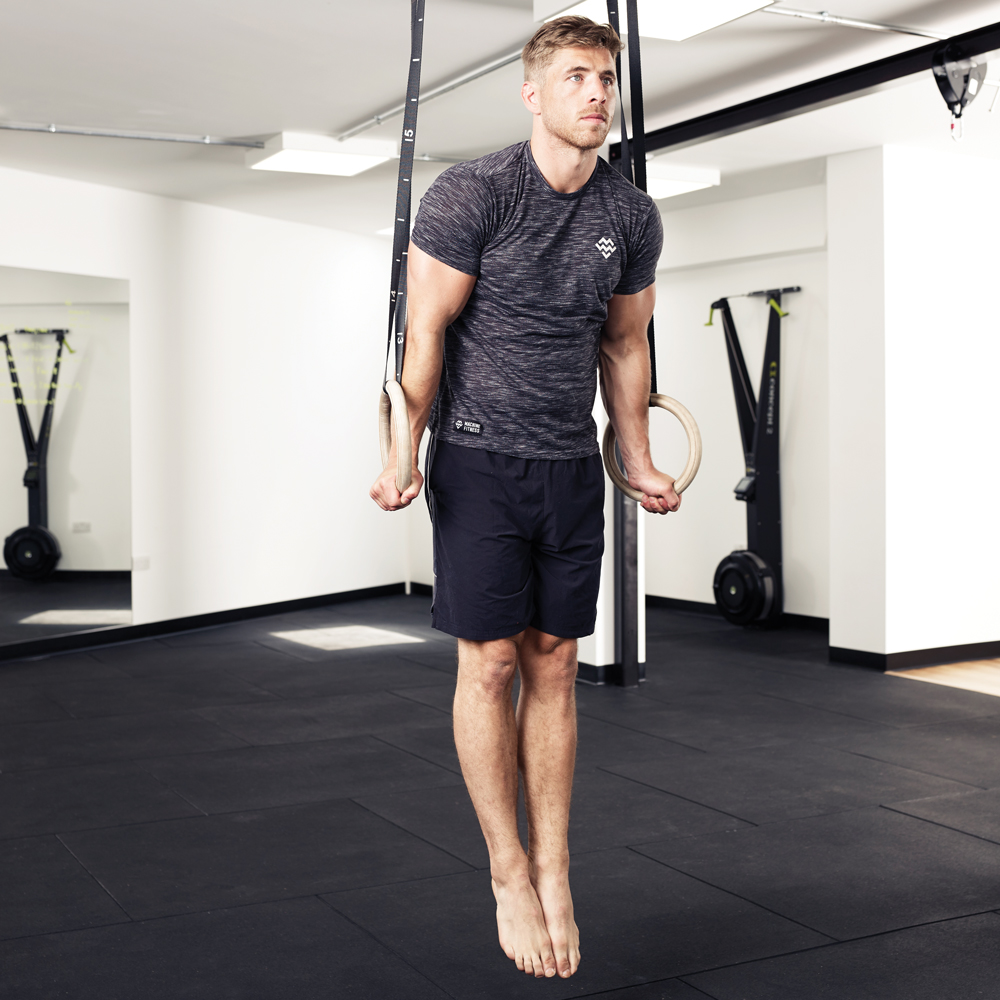
Target 15sec
Jump into the top position of a dip – elbows locked, rings close to your body, knuckles facing your sides. Hold for a second, then turn your knuckles outward. This locks your elbows into position, making the position more stable.
Tuck hang
Target 15sec
With the rings above you, grab on and hang with “activated” shoulders – aim to pull your shoulders away from your ears while keeping your arms straight. Tuck your knees to your chest and hold.
Press-up
Target 5 reps
It’s harder than the regular version, though keeping the rings close to your body will help. Lean forward on the rings and lower until their edges touch your armpits, then press up.
Pull-up
Target 5 reps
Start with your palms facing each other and brace your abs to minimise swinging. As you pull, twist your palms to face you, pause at the top – then lower.
Gym Rings Moves For Core Strength
To get abs of steel use the holy trinity of rings moves: the L-sit, front lever and back lever – each one works your core from a different angle. Do one of the three at the end of each of your weekly workouts.
L-sit
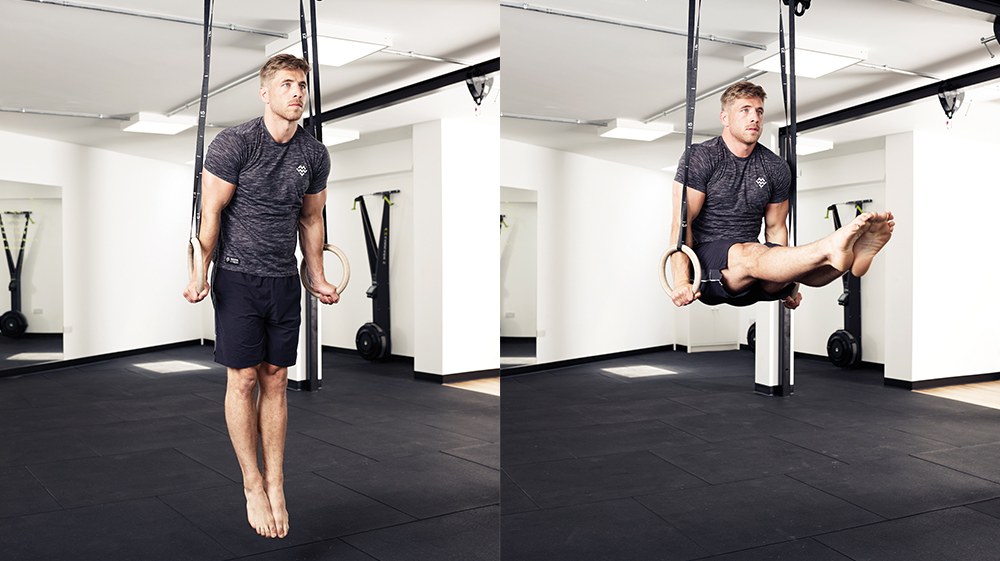
Targets Lower abs, hip flexors, obliques
From the top support position, bring your legs up until they’re parallel to the floor, brace your abs and hold. If your flexibility’s hurting you, practise the move on the floor: sit with your hands as far forwards as possible and bring your legs up slightly, then lower, for five reps.
How To Work Up To The L-Sit: For the first four weeks, do the tuck progression (see A, below), increasing the time each week as defined below. Then do the one-leg progression (see B, below for four weeks, then straddle, then you’ll finally be ready for full extension.
- Week 1: 3 x 5sec
- Week 2: 5 x 5sec
- Week 3: 3 x 10sec
- Week 4: 5 x 10sec
A Tuck Bring your knees to your chest and brace your abs. To do the advanced tuck, straighten your back and bring your knees to a 90˚ angle away from your body.
B One-leg From the advanced tuck position, bring one leg away from your body, then the other. You can also do this for reps, rather than time.
C Straddle Straighten your legs, keeping them as far apart as possible. The closer you bring them together, the closer to the full move you’ll be.
D Full Extension Bring your legs together and out in a straight line away from your body, bracing your abs and glutes to keep your body in a straight line. And hold.
Back Lever
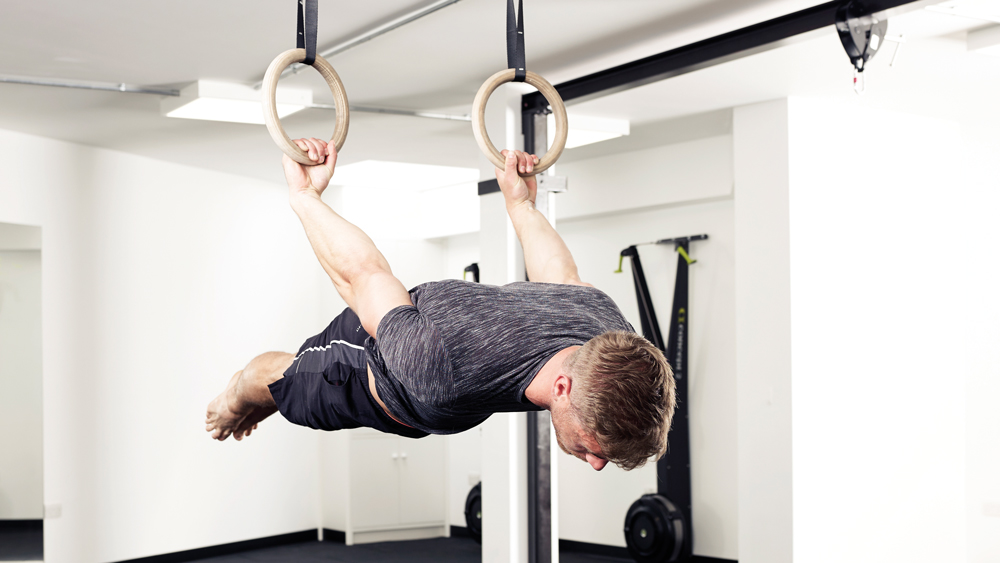
Targets Back, biceps, upper abs
Start like you’re doing a skin the cat (see below), keeping your legs straight. As your hips pass the top of the move, straighten your body so that you’re hanging parallel to the floor, face down. This move puts a lot of strain on your biceps, so do it when you’re fresh and don’t overdo the reps.
Front Lever
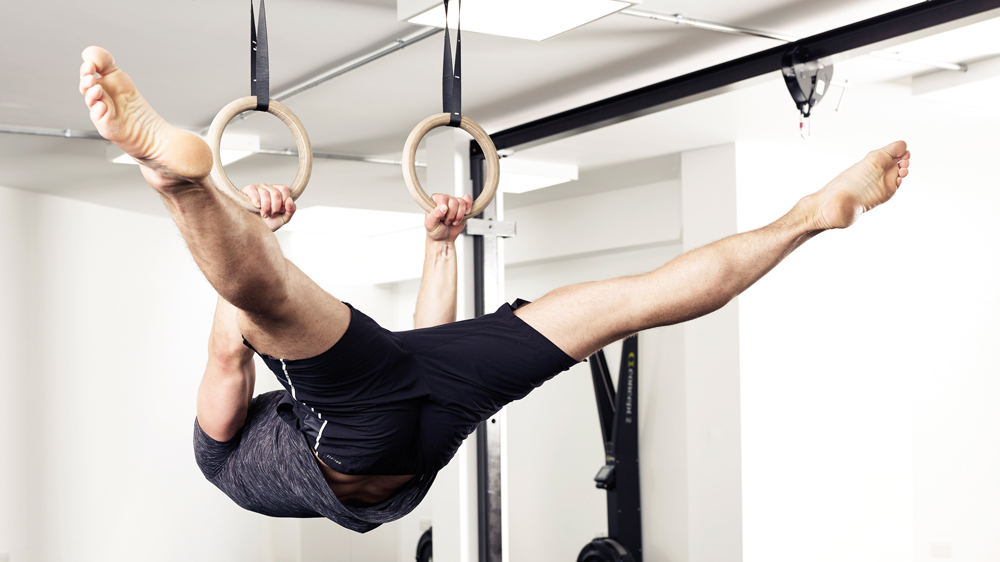
Targets Lats, upper abs
Much harder than the back lever. You’ll need to use your lats to lock yourself into position, which makes it extremely challenging. It might take longer to master than the other two moves, but it’s a solid show-off pose. Pull slowly into the position and brace your whole body.
Gymnastic Ring Exercises To Work Up To
The Shoulder Fixer: Skin The Cat
When you did this as a kid, it was easy. Now that you’re grown up, it’s fundamental to full-ROM shoulder strength. By hanging from the rings and then rotating your body through your arms, you take your shoulders to full extension, where you can hang in the position known as the German Hang for a stretch. Here’s the advanced version.

Word of warning: if you’ve had shoulder injuries take your time and progress slowly.
Progression 1: Tuck
Start from the tuck hang position. Use your abs to bring your knees up and over your head, then slightly behind you. If it’s comfortable, lower them behind you until you feel a stretch in your shoulders. Keep the rings low so you can put your feet on the ground when you’re done.
Progression 2: One-leg Hang
Next, bring one leg out ahead of you and do the move again. This time, focus on keeping your palms facing forward: this’ll make you stronger for the full straight-arm version.
Progression 3: German Hang
Now you’re going to keep both legs straight. Doing the move with your legs straight is an advanced version that requires a lot of core strength. Try to pull yourself over into the position and back again without any bend in your elbows or knees. It’ll also improve your pulling motion from the hips, making you better at everything from muscle-ups to Olympic lifts.
Show-Off Move 1: Archer Pull-Up
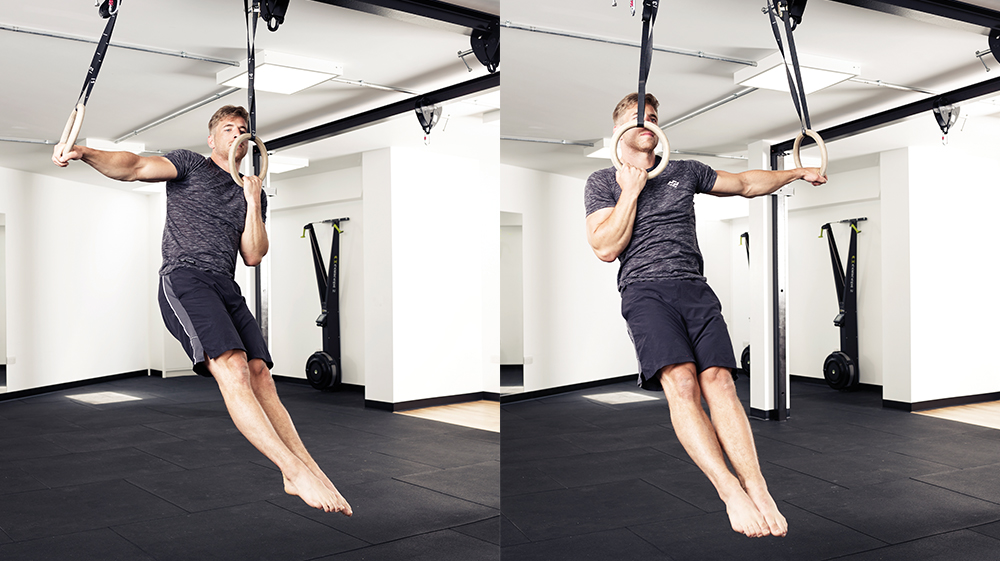
This move looks good alone, but it’s the entry-level version of something much more impressive. “If you’re trying to do a one-arm chin-up, it makes more sense on rings,” says Stark. “The rotation of the rings makes it much easier on your elbows.” There are three progressions to the full move – no added weight required.
Level 1: Push At The Top
For this variation, perform a pull-up as normal. Then, at the top, press one arm out to the side and bring it back in. Do another rep, and repeat on the other side. It’s barely tougher than the normal pull-up, but it requires control.
Level 2: Slow Down
Next , do your pull-up, press your arm out to one side at the top, then lower with that arm still straight. Repeat on the other side for the next rep. Focusing on the eccentric phase builds strength, while letting you keep control.
Level 3: Straight Up
For the toughest variation, keep one arm as straight as possible throughout an entire pull-up. You’ll get some assistance from the straight arm, which you can reduce as you progress to the one-arm chin.
Show-Off Move 2: Strict Muscle-Up
You’ve probably seen people do the “kipping” version, jerking and flinging themselves above the rings like a salmon ascending a waterfall. In gymnastics, though, the muscle-up is done strict: it’s a pull-up that transitions smoothly into a dip with minimal movement from the legs. It’s also a move that commands respect wherever you bust it out.
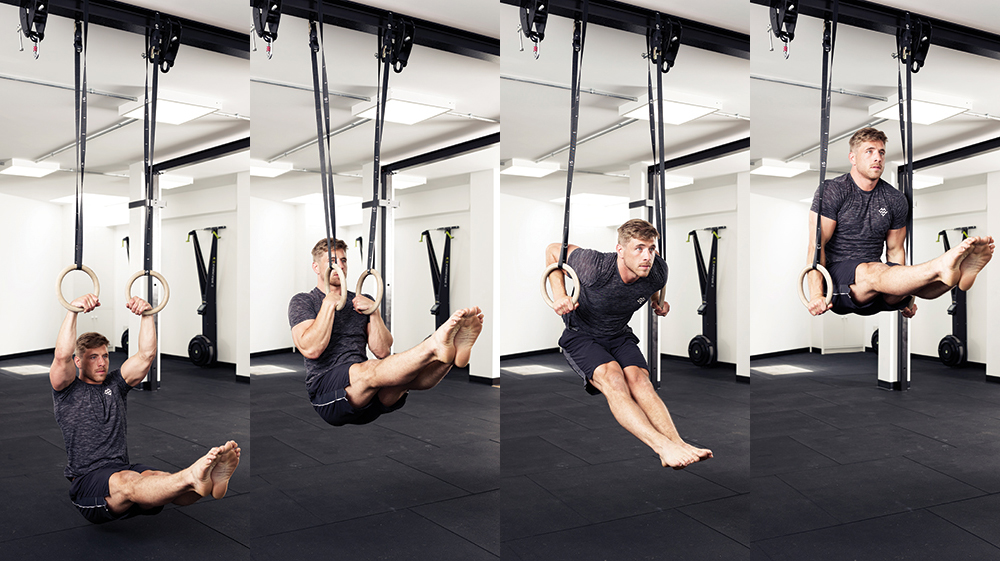
The version pictured above, with legs straight, requires a huge amount of core strength and is an advanced demonstration of the move. Start by using the form guides on the right – once you’ve perfected the basics, you can try the straight-legged version.
Step 1: The Grip
For the muscle-up, you’ll need to use a “false” grip, which means keeping your wrist above the rings. To do it, grip the ring and then point your knuckles back towards you, bringing the ring close to the crease of your wrist. At first, you’ll barely be able to straighten your arms from this position. Work on hangs, rows and finally pull-ups to get used to it.
Step 2: The Pull
You’ll need a solid body position and a strong pull to get up to the transition part without kicking. Bring your feet forward with straight legs and brace your abs, then pull your body as high as possible while holding the position – your goal is to get to the point where your chin’s above your knuckles. Keep it slow and controlled. Do five sets of as many reps as possible two or three times a week, until you can do five controlled reps.
Step 3: The Transition
The tricky bit. During the transition, you’ll need to roll your shoulders forwards to get your weight over your hands for the final push. Your body comes between your hands as you bring your head forwards. To get used to it, use the “baby muscle-up”: kneel on the ground and pull, using assistance from your legs as you move through the transition. Practise for a few sets each session until you’re comfortable.
Step 4: The Push
This is the easy bit – if you can manage a handful of full-range ring dips, you’ll do it easily. From the top, reverse the move and control the transition down to build eccentric strength throughout the whole rep.
Show-Off Move 3: Forward Roll
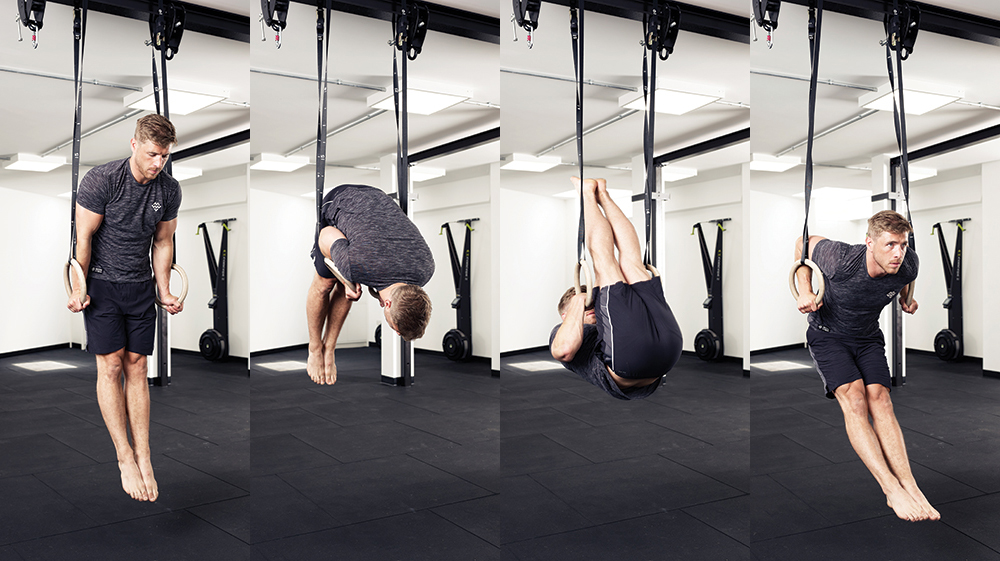
It’s not even entry-level in Olympic gymnastics, but it’s one of the most impressive things you can do in a gym and it takes serious strength, control and co-ordination. “You’re essentially starting at the top of a dip, rolling over the rings and then pulling back into the start position by doing a very controlled form of muscle-up,” says Stark. So the strict muscle-up is a prerequisite. Once you’ve nailed that, here’s how to do the move.
Start in the top support position, then raise your hips as you lower into a dip. Your hips should be higher than your shoulders as you reach the bottom of the dip. Keeping your arms bent, maintain a false grip and keep the rings close to your chest as you allow your head to roll under the rings. When your hips start dropping, fight to keep your feet high. Go straight into a muscle-up to return to the support position.
From 2008 to 2018, Joel worked for Men's Fitness, which predated, and then shared a website with, Coach. Though he spent years running the hills of Bath, he’s since ditched his trainers for a succession of Converse high-tops, since they’re better suited to his love of pulling vans, lifting cars, and hefting logs in a succession of strongman competitions.










